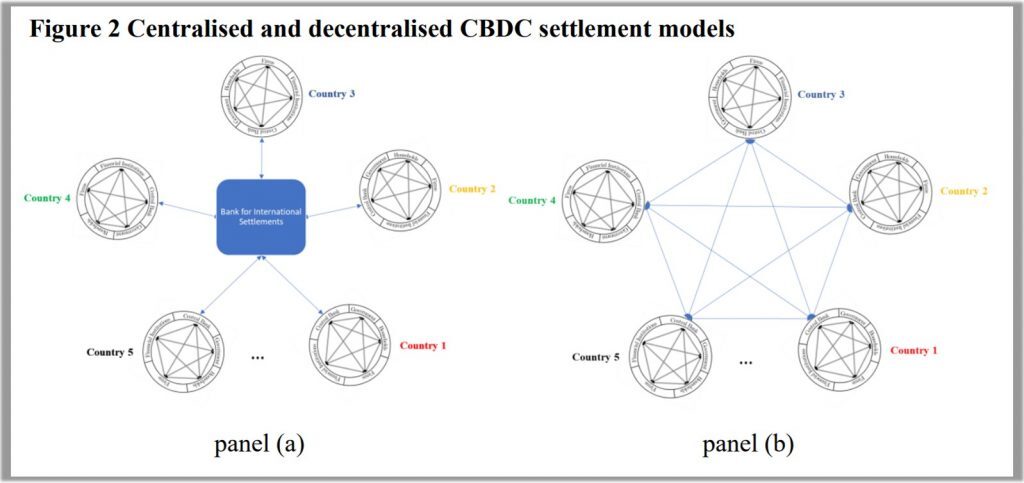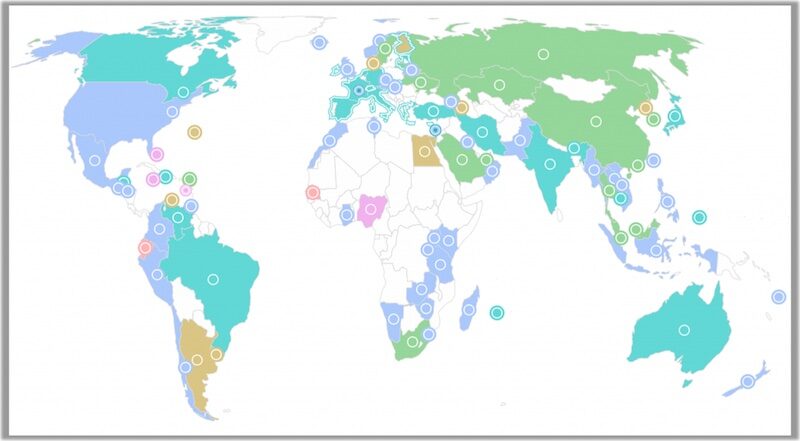Comment: Not only a thorough update on the Big changes we're going to see in much of the world's monetary system in the not-too-distant-future, but also one of the most comprehensive discussions about the implications of CBDC's we've yet seen...
When asked if a United States CBDC would be used to control how, when and where the population spends their money, a senior vice president for the St. Louis Fed's Research Division responded, "in life, one can't give absolute assurance of anything...The best we can hope for, is for Congress to respond to the electorate's concerns about privacy." However, signals by the Biden regime and the Federal Reserve indicate they intend to move forward on a CBDC, regardless of any approval from Congress, industry leaders or the public. In fact, there are a growing number of research and pilot programs in various phases of development in America and around the world, despite public concerns of an impending digital currency enslavement system tied to a digital ID and social credit system.
The Biden Regime Presses Forward
On March 9, 2022, the Biden regime issued an Executive Order on 'Ensuring Responsible Development of Digital Assets,' which placed "the highest urgency on research and development efforts into the potential design and deployment options of a United States CBDC." The EO commanded Attorney General Garland, Treasury Secretary Yellen, and Federal Reserve Chair Powell to determine if a legal path to bypass Congress is possible, stating, "within 180 days of the date of this order [by September 5, 2022], provide the President...an assessment of whether legislative changes would be necessary to issue a United States CBDC, should it be deemed appropriate and in the national interest." The EO further directed them to provide the President with a legislative proposal within 210 days, by October 5, 2022.
A former Fed vice chair, Randal Quarles, remarked that any bill in Congress authorizing a CBDC would be unlikely to pass, noting a lack of support from the public. In July of 2021, lawmakers introduced legislation that has yet to pass, known as the 'Digital Asset Market Structure and Investor Protection Act,' which appears to authorize the Fed to issue digital versions of Federal Reserve notes and to use distributed ledger technology for the "creation, distribution and recordation of all transactions involving digital Federal reserve notes." On the other hand, legislation was introduced in January of 2022 to prohibit the Federal Reserve from issuing a CBDC directly to individuals. In March of 2022, legislatures proposed an alternative to CBDC in a bill known as the 'ECASH Act', which proposes to develop an electronic version of the US dollar issued by the US Treasury instead of the Federal Reserve, and purports to imitate the privacy and anonymity features of cash. While there is no current federal statute mandating businesses to accept cash, lawmakers introduced the 'Payment Choice Act of 2021', designed to require retail businesses to accept cash as a form of payment. In all, Congress has introduced 50 bills on digital assets, blockchain, and CBDCs.
During a May 26, 2022, House Committee hearing, some lawmakers took issue with the Biden regime's Executive Order and the ambiguity of the Federal Reserve's comment in their January 2022 discussion paper, which states, "The Federal Reserve does not intend to proceed with issuance of a CBDC without clear support from the executive branch and from Congress, ideally in the form of a specific authorizing law." Representative Andy Barr commented, "This to me suggests that the administration is not yet convinced that Congress has a role here." Lawmakers were unable to seek clarity from the vice chair of the Federal Reserve during the hearing on whether the Fed would in fact proceed with the issuance of a CBDC without official Congressional authorization.
Source: 'Digital Assets and the Future of Finance,' U.S. House Committee on Financial Services, May 26, 2022
Other issues raised in the House Committee hearing on CBDCs included risks to the public of mass surveillance and targeting of citizens who are critical of the regime. Representative Warren Davidson remarked to the Fed vice chair, "The concern is the surveillance state... If you turn the Central Bank Digital Currency into this creepy surveillance tool...it literally is what China is developing and we shouldn't imitate them. We should protect America's way of life." The threat of adopting China's model for surveillance and control has become even more apparent in recent days, as China thwarted attempts by protesters to access their frozen funds by turning their QR codes red. Representative John Rose addressed his concerns to the vice chair, adding, "We saw how dangerous it can be when the government weaponizes the financial system for political purposes under the Obama Administration's Operation Choke Point. More recently, the Canadian government instructed banks to freeze accounts linked to the trucker protests over vaccine mandates...Without appropriate safeguards, would a CBDC make it easier for the federal government to block individuals it disagrees with from accessing the financial system?" Vice Chair Brainard did not deny that CBDCs could be used to block access of individuals, stating that the use of CBDCs would essentially be no different from the current banking systems, from which accounts of political dissidents have been frozen.
Source: 'Digital Assets and the Future of Finance,' U.S. House Committee on Financial Services, May 26, 2022
Legislatures aren't the only ones concerned about the rise of the CBDC surveillance system. Both the public and shareholders were invited to submit comments on the Federal Reserve's plans to issue a CBDC, many of whom were resolutely opposed to the idea. One citizen wrote, "You don't want privacy. You want to control every aspect of our lives." Another individual replied, "I do not want government in charge of access to the kill switch to my account/money if I do not 'tow the line.'" Yet another responded, "Stop playing games with our lives. And ignore Klaus Schwab. I fear the system completely breaking down if CBDC is enacted. Because Americans want privacy, freedom, and their work rewarded with sound money."
In response to the Fed paper on CBDCs, the American Bankers Association warned how the disbursement of a CBDC would devastate local banks, stating, "The issuance of a CBDC would fundamentally rewire our banking and financial system by changing the relationship between citizens and the Federal Reserve," adding, "The risks associated with issuing a CBDC are often downplayed but are real and likely to undermine any possible benefit that a CBDC would have. Most importantly, every construction of CBDC requires moving funds from banks to the Federal Reserve." The ABA concluded, "As we have evaluated the likely impacts of issuing a CBDC it has become clear that the purported benefits of a CBDC are uncertain and unlikely to be realized, while the costs are real and acute. Based on this analysis, we do not see a compelling case for a CBDC in the United States today."
Despite numerous dissenting voices among Congress, industry leaders and the public, the Biden regime and the Federal Reserve are pressing forward with plans to develop a United States CBDC. The Fed released yet another paper on the issuance of a retail CBDC in April of 2022. On June 17,2022, Fed Chair Powell lamented the decline of the US dollar as the world's reserve currency (driven by reckless federal spending and intentional mismanagement) and looked to a United States CBDC as a solution to the problems they've created, stating, "Looking forward, rapid changes are taking place in the global monetary system that may affect the international role of the dollar in the future. Most major economies already have or are in the process of developing instant, 24/7 payments. Our own FedNow Service will be coming online in 2023. And in light of the tremendous growth in crypto-assets and stablecoins, we are examining whether a US central bank digital currency would improve upon what is an already safe and efficient domestic payments system. As our white paper on this topic notes, a U.S. CBDC could also potentially help maintain the dollar's international standing."
Research & Development Projects Underway
There are a multitude of research and development programs for CBDCs underway. Currently, 105 countries, which represent more than 95% of the global GDP, are in various phases of CBDC exploration. Approximately 50 countries are in the advanced phases of research and development, while 28 retail CBDC pilots and 3 live retail CBDCs have been implemented. A study of 81 central banks determined that 90% are currently researching CBDCs, and over half are in the developmental or experimental phases. Several key areas of CBDC exploration are highlighted below.
China & e-CNY Project
China's CBDC pilot program continues to expand since the announcement of its launch in 2020, gaining 261 million digital wallets opened in 2021. The Chinese government has extended the program to include more regions and applications. As China's CBDC pilot program expands, so do their surveillance capabilities of Chinese citizens, multinational corporations, and other consumers around the world. On May 25, 2022, Senators introduced a bill known as the 'Defending Americans from Authoritarian Digital Currencies Act,' to prohibit app platforms, such as Apple and Google, from hosting apps that accept China's digital currency. Senator Tom Cotton commented that the digital currency will provide the Chinese government with "real-time visibility into all transactions on the network, posing privacy and security concerns for American persons who join this network," adding, "The Chinese Communist Party will use its digital currency to control and spy on anyone who uses it. We can't give China that chance." On June 7, 2022, lawmakers introduced a bill in the Senate known as the 'Responsible Financial Innovation Act,' to regulate crypto and to direct several agencies including: CISA, ODNI, and the DoD to investigate the national security implications of the use of China's CBDC.
United States & Project Hamilton
The Federal Reserve Bank of Boston and MIT Digital Currency Initiative are collaborating on a CBDC exploratory project known as 'Project Hamilton.' The first phase of the operation was completed, demonstrating the feasibility of a CBDC payment system similar to the scale of the US economy and the US dollar's utilization globally. Phase 2 of the project will focus on security, programmability, "how to balance privacy with compliance," and safeguards against cyber-attacks. Critics argue that a United States CBDC does not address the issues of cybersecurity, government abuse, privacy, and centralized control. Congressman Tom Emmer commented, "Not only would this CBDC model centralize Americans' financial information, leaving it vulnerable to attack, but it could also be used as a surveillance tool that Americans should never tolerate from their own government," adding that, "Requiring users to open up an account at the Fed to access a US CBDC would put the Fed on an insidious path akin to China's digital authoritarianism." Laying the foundation for their CBDC program, the Fed has developed "a new instant payment infrastructure" known as FedNow. The new digital interbank instant payment system is expected to launch in 2023.
European Union & Digital Euro Project
The investigation phase of the Digital Euro Project began in October of 2021 and will be completed by October of 2023. As part of the investigation phase, the European Central Bank has solicited public feedback. The ECB received 8,200 public responses, a record number of participants in the survey that ended in January of 2021. The feedback from this consultation provided a clear mandate, with the majority of respondents confirming that the public wants "payments to remain a private matter." The ECB again solicited public feedback in a survey that ended in June of 2022, which received well more than double the number of responses as the previous survey. Once again, the public survey determined an overwhelming rejection of "digital slavery," from a CBDC "slavecoin." One respondent wrote, "No to the digital Euro! Living in the EU is becoming a nightmare, with forced vaccinations on the horizon, and now a digital Euro. It is clear that you want to have a population with no rights and no privacy - as wanted by your overlords of the WEF." Despite the crushing negative public responses to a CBDC over privacy concerns, the European Central Bank is moving forward with their plans. European Commissioner Paolo Gentiloni remarked to the press that, "A completely anonymous digital euro is not desirable." A digital euro prototype is expected to launch in late 2023.
International CBDC Projects
While central banks are exploring and developing their own CBDCs, there are a number of collaborative projects to coordinate the exchange of CBDCs globally. Between 2017 and 2019, the Bank of Canada completed a four-phased program known as Project Jasper, in coordination with the Bank of England and Monetary Authority of Singapore. The project marked, "the first time in the world that a central bank participated in a distributed ledger technology experiment in partnership with the private sector." The Saudi Central Bank and Central Bank of the UAE announced their joint initiative known as Project Aber in January of 2019, which included the involvement of commercial banks and businesses, and aimed to develop a CBDC that could be used between commercial banks across borders.
In December of 2020, the first phase of Project Helvetia, a partnership between the Bank for International Settlements, the Swiss National Bank, and a financial infrastructure company known as SIX, was completed. Phase 2 of the project, which was completed in January of 2022, focused on integrating commercial banks and CBDCs.
In December of 2021, the Bank for International Settlements announced the conclusion of Project Jura, an experiment in transferring CBDCs between French and Swiss commercial banks on a shared third-party platform. The joint operation, designed to continue the experimentation done under Project Helvetia, included the Bank for International Settlements, the Bank of France and the Swiss National Bank.
In September of 2021, China, Thailand, Hong Kong, the UAE and the Bank for International Settlements released a report on the second phase of their mBridge Project, which included the participation of 22 private sector participants. The project aims to develop a platform for international trade using CBDCs. Also in September of 2021, the Bank for International Settlements announced Project Dunbar, in collaboration with Australia, Malaysia, Singapore, and South Africa. A report released in March of 2022 outlined how the project has developed two prototypes that enable CBDCs issued by multiple banks to use a shared platform.
On June 16, 2022, the Bank for International Settlements announced a partnership on Project Sela, including the Bank of Israel and the Hong Kong Monetary Authority. The joint project, which kicks off in the third quarter of 2022, aims to test the feasibility of a retail CBDC.
In September of 2020, Mastercard announced the launch of their CBDCs testing platform for central banks to simulate the "issuance, distribution and exchange of CBDCs between banks, financial service providers and consumers." In January of 2022, Visa joined Mastercard in offering central banks a platform to test CBDCs and Visa products. More projects to develop CBDCs can be found on the BIS Innovation Hub.
In summary, the broad range of CBDC research and development projects across the globe is immense. Joint operations across borders are paving the way for international exchange of CBDCs, and ultimately a single global digital currency as promoted by the World Economic Forum.

Final Thoughts on the Rise & Risks of CBDCs
The development and implementation of CBDCs in America and around the world is moving forward, with a multitude of projects underway and many of those projects coming to fruition within months. Central banks and global powers seem undeterred by objections from their citizens or the indecisiveness of Congress. Though there are numerous models for implementing CBDCs, they all share the same risks to our freedom. Lack of anonymity, programmability, tracking, and centralized control are the key features of CBDCs, which will enable subjugation of the masses in the most extreme ways imaginable.
The enormity of this all-encompassing initiative to implement CBDCs around the world is daunting. It seems inevitable that this end-game system of global totalitarianism will become a reality. However, we must be encouraged that the people are becoming aware of the true agenda behind this financial takeover. Their digital control system depends on our submission, and we each have the choice to not comply. By removing ourselves from the system and using cash instead of their digital wallets and debit cards, we can starve this rising beast of data and banking fees. Only together, in mass noncompliance, will their plans for digital enslavement become unrealized.






Genesis 2:11-12
"Now a river went out of Eden to water the garden, and from there it parted and became four riverheads. The name of the first is Pishon; it is the one which skirts the whole land of Havilah, where there is gold. And the gold of that land is good. Bdellium and the onyx stone are there."